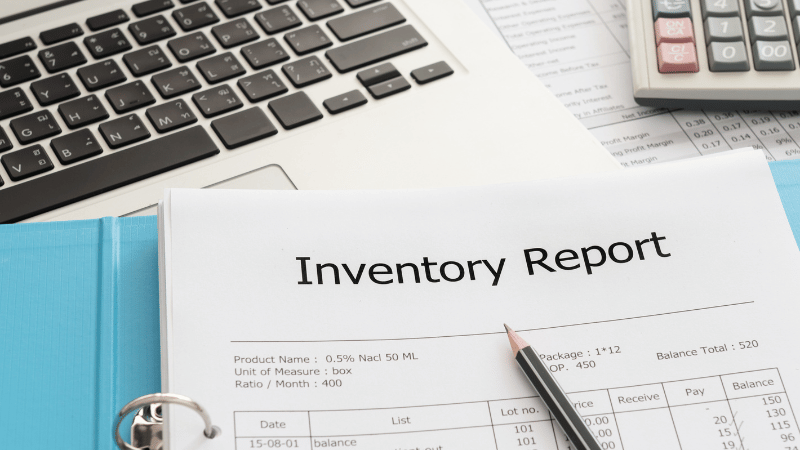Categories
Inventory Finance | Everything You Need to Know

Running a business that depends on the buying and selling of items can make cashflow difficult.
Problems such as the seasonal nature of the business, or the need to hold large amounts of slow-moving inventory to make sure you have the stock on hand when it’s needed, can put pressure on business finances.
Enter inventory finance.
Inventory finance (also called stock finance or warehouse financing) is a form of business funding that uses the products held in your inventory as collateral for a loan. It’s easy to apply for, able to fund increasingly large stock levels, and smooths business cash flow.
What is Inventory / Stock Finance?
A form of asset-based finance that uses the security of your inventory to mitigate risk for the lender, inventory finance takes two main forms:
- A business loan, structured with regular repayments, guaranteed by the inventory as collateral.
- A revolving credit facility, providing long-term cash flow support that can be utilised as needed.
The way it works is relatively simple. One of the biggest problems for businesses looking to secure finance is the risk they present to the lender, especially when looking to obtain larger loans or lines of credit.
With inventory finance, that security is met with the stock you have on hand.
Inventory finance helps by:
- Enabling businesses to access higher-value loans and lines of credit
- Helping businesses with poorer credit histories obtain finance
- Providing capital to buy more inventory
- Smoothing the cash flow during dry seasons
- Giving companies the breathing room needed to expand
Inventory finance is not just for businesses with large amounts of existing stock, but is also for businesses looking to purchase inventory. Collateral can be provided either by inventory that’s already on hand, or inventory that is bought using the financing.

How Much Inventory Finance Can I Get?
Think of inventory finance like a mortgage: with a mortgage, you can get a loan using your home as security, or you can take out a loan to buy a home. Inventory finance is the same, only you are using your goods as the security, rather than your house.
Inventory finance uses some similar terms as a home mortgage, too. One of those is loan-to-value or LTV.
LTV is a calculation of how much you can borrow (the ‘loan’ or ‘L’) against the value of the security (the ‘value’ or ‘V’).
This value, of course, isn’t based on the retail price of your stock, but rather on the amount the finance company can realistically expect if it is liquidated. This is commonly known as the liquidation value or LV. LV will depend on the market and type of goods in your inventory.
Though they are closely linked, it’s important not to confuse LTV and LV!
The 3 Different Structures of Inventory / Stock Finance
There are three core structures to inventory finance, allowing businesses to choose the one most suited to their needs.

Inventory Loans
An inventory loan is the simplest form of stock finance. It works by providing a one-off lump sum loan based on the value of your inventory.
The loan is subject to interest, and is structured with monthly repayments in a familiar fashion. Once all the repayments are made, the loan is cleared.
In many forms of asset finance, the collateral is directly tied to the loan and cannot be sold on or refinanced while it represents security in the finance; however, inventory loans are specifically designed to provide funding for goods that are intended for sale.
Depending on the terms of the inventory loan agreement, if the stock is sold early, it may be a condition that the loan is repaid in full with the proceeds. However, in many cases, the loan merely continues with its defined repayment schedule. It is important to check the terms of any inventory loan agreement to be clear on this circumstance.
Like any loan, an inventory loan will accrue interest. The interest rate will depend on several factors including:
- The type of goods used for security
- The business credit history
- The length of the loan term
- The business sector
To get a favourable loan rate, it is worth speaking to a specialist business finance broker, such as Clifton Private Finance. Our experts have access to the full range of UK lenders and all the experience needed to determine the best deals. Contact us today to discuss an inventory loan for your business.

Inventory Lines of Credit
An inventory line of credit, or revolving credit facility is an open and continuous stream of credit that’s similar to a credit card.
The credit limit of an inventory line of credit will be based on the LV of your inventory, in a similar way to an inventory loan.
In this manner, the inventory line of credit provides essential purchasing power that will enable your business to expand without putting any direct strain on your bank account.
An inventory line of credit will be subject to both fees, typically a set-up fee and a regular administration fee, as well as interest.
That interest, however, will be applied only on the amount of credit used; a well-managed revolving credit facility can provide the flexibility of premium cash flow without incurring the larger sums of interest that a similar inventory loan would accrue.
It is essential that an inventory line of credit is managed properly. This means that paying it back as goods are sold is important.
Leaning too heavily on a line of credit can result in increasingly high interest charges and, in the case of an inventory line of credit, may break the terms of the agreement.

Floor Plan Finance
A third type of stock finance is that of floor plan finance. A rarer form of invoice finance, floor plan finance has been developed to allow businesses that trade in high-value items to obtain financing that is better structured for their needs.
Floor plan finance works as a loan in a similar way to an invoice loan, only it replaces the monthly repayments with a payment plan based on the sale of goods. As each item is sold, a chunk of the finance is repaid until it is finally repaid, along with any interest, once the final item that was used as security is sold.
Floor plan finance is a specialist niche product. If your business would benefit from its unique set up, contact a business finance expert at Clifton Private Finance to find out more.

The Benefits of Inventory Finance
Inventory and stock finance has a number of advantages that make it the right product for goods-based businesses. These include:
- Cash flow management - Inventory finance helps smooth the seasonal nature of product sales by effectively converting held stock into working capital. This can be essential for meeting monthly liabilities, such as salary payments, rent, and utility bills.
- Flexible collateral - Many business owners and directors work with the mistaken impression that only traditional fixed assets, such as property or machinery, can be used as security for asset-based finance, and that such assets are locked and prevented from sale when leveraged in this way. Inventory finance has no such limitations and has a more flexible approach to loan security.
- Improving stock availability - Through inventory finance, businesses can expand their stock lines, providing customers with wider choice that, in turn, builds loyalty and repeat business. Seasonal demand can be handled with ease, avoiding the limitations of struggling cash flow.
- Support for growth - Inventory loans and lines of credit free up capital for expansion use, allowing for additional marketing or staffing to build sales. Companies that release the equity tied up in inventory are more able to use their working capital to scale the business.
Stock Finance Disadvantages
As with any finance option, inventory finance is not without its costs and risks.
- Interest and fees - Inventory finance will incur interest and fees, lowering your profit. For businesses with already-tight margins, the additional costs of inventory finance can be an unwanted expense.
- Depreciation - Goods are liable to depreciate, especially if stock is hold for a particularly long time before being sold. If the goods depreciate significantly before the finance is repaid, it can lead to a shortfall and ongoing finance issues. It is important to consider depreciation and calculate its impact before using inventory finance.
- Repayment challenges - If sales forecasts are a little too optimistic and fall short, the business may be unable to meet the repayment terms, leading to compounded interest and a slip into financial difficulties. It is important to get refinancing advice from a specialist such as Clifton Private Finance as soon as potential shortfalls are anticipated.

Inventory Finance Considerations
Before choosing inventory finance, consider the following:
- Your business need - Properly assess your business and the need for inventory finance - how much funding are you looking for, and how long will it be before the goods are sold and you can repay the finance?
- The type of finance - Are you looking for a lump-sum loan or a longer revolving line of credit? Consider the long term implications of each and how you intend to manage the finance.
- The inventory value - The better your inventory holds value and the higher LV a lender will assign, the more finance you will able to obtain and the better rate you will get.
- Choosing a lender - It is important that you get the right lender. Those who understand your market sector and have experience in similar financing will be a better fit than one that is more generic. Specialist inventory finance lenders have better assessment processes as well as superior support. To find the right lender, it’s worth speaking to Clifton Private Finance. As an independent business finance broker, our team have established relationships with the wide range of industry-specialist lenders in the UK and will help match you to a suitable lender who offers the best rates and long-term advantages for your business.
Applying for Inventory Finance
Like all loans, you will need to present yourself to the lender as a stable business. Prepare your documentation in advance, including:
- Business and personal identification
- Financial statements
- An evaluation of your inventory value
- Sales history and forecasts
When using Clifton Private Finance, an application is a smooth process that won’t take long. Speak to one of our advisors to discuss your need and we’ll get you on the path to your inventory finance.

Examples of Inventory Finance
We’ve discussed some of the basic uses for inventory and stock finance, but what does that mean in the real world? Consider the following examples:
Our Latest Business Finance Case Studies



6 Alternatives to Inventory Finance
Inventory finance is one of a range of business finance options and agreements that can help with cash flow and expansion. Other options include:

Trade credit
Finance from the supplier rather than a finance provider, trade credit is a system whereby the supplier offers extended invoice terms or staggered repayment options for the purchase of goods to allow you the time to sell on the items before having to make the payment.
It has the additional advantage that once the terms are up with the supplier, it is possible to get traditional financing to make that payment, providing an even greater payment period.
Trade credit must be negotiated one-on-one with each supplier and cannot be offered through a broker or bank.

Invoice finance
Like inventory finance, invoice finance is a form of asset-based loan, only one where your accounts payable is leveraged as collateral rather than your inventory. It provides a viable alternative to inventory finance to companies that supply a small number of customers with particularly large orders which are then paid via invoicing.

Merchant cash advance
Businesses that do a considerable amount of their trade through card transactions can take advantage of merchant cash advance, which provides instant capital based on a flexible repayment structure of future forecast sales.

Traditional loans
Both secured (asset-based) and unsecured business loans provide a way for companies to raise the capital needed to buy stock. There is a wide range of traditional loans and shopping around for the best rates is essential.

Credit cards and overdrafts
The simplest forms of revolving credit facilities, both company credit cards and business account overdrafts offer an aid to cash flow for businesses. Like all lines of credit, however, credit cards and overdrafts must be well managed to avoid future financial difficulties.

Asset-refinance
Leveraging larger existing assets, such as vehicles or machinery, asset-refinance releases the equity locked in those assets, providing capital that can be used for the purchase of inventory.
If you have a number of medium to high-value assets, then asset-refinance may be an excellent alternative that offers competitive rates and terms.

Apply with Clifton Private Finance
Using your inventory as assets for a loan or line of credit is an excellent way to develop your sales-based business.
At Clifton Private Finance, we have the expertise you need to find a specialist lender that will be a perfect fit for your business.
To learn more about inventory and stock finance, and to begin an application that can result in an influx of capital for your business in just a few working days, call us at Clifton PF today.





